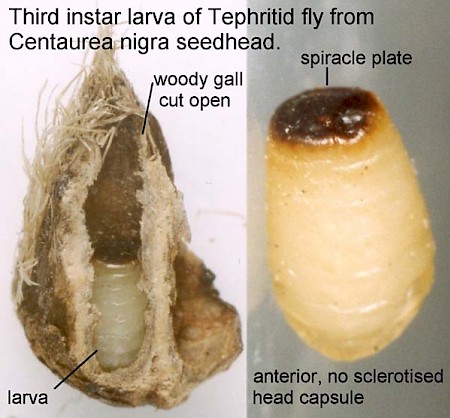
35.058 BF726
Metzneria metzneriella
(Stainton, 1851)
Wingspan 14-19 mm.
The commonest of the six British species of Metzneria, and distributed throughout England, Wales and southern Scotland. It also occurs locally in Ireland.
The moths are on the wing between June and August, occupying dry pastures and calcareous soils.
The larvae feed on the seeds of common knapweed (Centaurea nigra) or saw-wort (Serratula tinctoria), overwintering in the seedhead before pupating in late spring.
- Larva: (description Ian F. Smith):
Foodplant: October to April in seed head of Centaurea nigra and Serratula tinctoria. Larva burrows among and below seeds and, sometimes, a short way down the stem. Larva hibernates in a brownish capsule below the seeds or wedged among woody galls of Tephritid fly larvae.
Length: 5 mm
Head: Dark brown. Adfrontal area black and substantial black border on posterior of capsule. Stemmatal area concolorous.
Prothoracic shield: Transparent yellowish white showing dark head under anterior. A large triangular area of raw umber (blackish brown) tinting on either side of median line, merging at the anterior of shield, and tapering to an apex at posterior where there is often a dark brown spot of surface pigment.
Thoracic legs: Small, transparent, concolorous. Tibia and tarsus tinted light brown.
Body: Shaped as Diptera larva. Off-white, greasy appearance. On each side of segments A1 to A5 there is an area, which can be slightly depressed, or inflated at will into a protuberance.
Spiracles: Peritreme burnt ochre.
Pinacula: Indiscernible.
Setae: Small, transparent, colourless.
Anal plate: Translucent, tinted greyish-brown. Off-white at bases of setae. Dark brown spots on cuticle arranged in a transverse band at anterior and a curved line at each side.
Prolegs: Obsolete, minute points visible at x40 magnification. Anal prolegs, vestigial, but larger, greyish-brown postero-laterally.
Similar species: M. neuropterella is sometimes found in C. nigra on downland in the south of England. It has a mahogany-brown head and pale brown marbling on the prothoracic plate (MBGBI 4-2).
Larvae of Urophora spp. of Tephritid flies are often abundant in Centaurea seed heads. Their colour, size and body form closely resemble that of M. metzneriella, but the latter is distinguished by its brown lepidopterous head and prothoracic shield. But take care not to confuse the dark brown posterior disc on third instar Urophora larvae for the brown head of M. metzneriella. Some species ofUrophora form hard woody galls that may fill most of a seed head, but M. metzneriella can still sometimes be found wedged between the galls.
Comment: Adults can be reared by collecting seed heads in winter, and keeping them outdoors in stockings until the start of June, when they can be brought inside and placed in a transparent container for emergence. More immediate records can be obtained by opening seedheads in winter to find larvae. A scalpel or penknife may be needed to break apart the woody galls of Tephritids, among which M. metzneriella may be concealed. Frequently 50%, or more, of seedheads are occupied.

 UKMoths
UKMoths 






